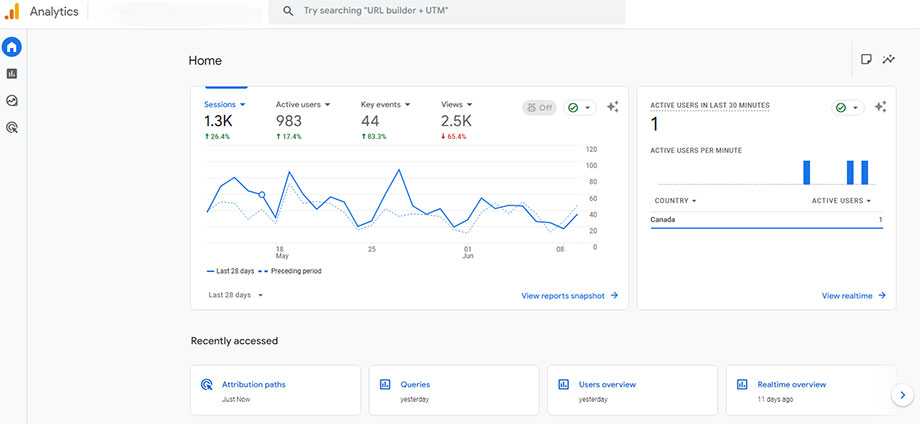
By: Jeremy Mayer Jul 9/2025
Figuring out digital marketing for your small business without support can be overwhelming. There are so many different strategies, tools, and platforms that it’s hard to know where to start. There is also a staggering amount of information online that can sometimes be contradictory. At Snaptech, we create tailored strategies for our clients’ specific needs, which is why we’ve put together this blog to help you get a better general idea of where to start for your business.
Before diving into a marketing strategy that will cost you money or time, there are two things to ensure have been set up correctly:

Google Ads – one of the most well-known and effective digital marketing strategies for e-commerce and service-based businesses. The most common of these are Search Campaigns, commonly referred to just as Paid Search. The reason Paid Search is such an effective marketing tool is that it captures search volume that is already there. It does not need to create awareness or interest. Your ads will show up for a portion of searches made in your target region (depending on your budget and a variety of other factors). For example, if someone needs a plumber, they go to Google and look for one in their area, if you’re running Google Ads for those terms you have a chance to show up and, since the person has a need for a plumber in that instance, you also have a chance to capture that click to your site and convert that person into a customer and revenue for your business.
Google Ads also allows for a few other marketing tactics:
SEO/Organic Search Optimization – another search-based strategy, but this time one that you don’t have to pay for every click. Sounds perfect, doesn’t it? This is generally what you mean when you think “I want to be number one in Google”. The challenge for SEO is that it’s a much slower tactic. Google is happy to stick you in the top ad spot when you’re paying for Google Ads (since they make money from that), but when you’re working on SEO, many different factors come into play, including on-page SEO, content for SEO, technical SEO, local SEO, and backlinking. It takes the right combination of these through careful implementation and strategic focus to get your site to move up in the search rankings. Sometimes it can take 3-6 months to even start to see some positive return on SEO efforts. However, SEO shouldn’t be ignored due to this; it is the most cost-effective way to generate customers and revenue since it is still heavily intent-based and doesn’t cost you for every click.
Social Media Ads – a blanket term for paid ads on platforms like Meta, Facebook, Instagram, and LinkedIn. These strategies can be very effective at awareness but also strong at generating sales and lead generation. They have significantly better targeting to demographics and interests than Google Display ads, since social media tools capture a lot more of that data from us. They are usually best for businesses with strong visual (image and video) assets.
Amazon Ads – these are ads that promote your Amazon listings in their search results and on similar product pages. Relevant for e-commerce businesses with an Amazon account and products on Amazon.
Organic Social Media – A strong brand-building strategy for posting organically on Facebook, Instagram, LinkedIn, or other social platforms. This helps to get your name out there organically, but is another slower process as it takes time to build up a strong following.
AI Marketing – a relatively new field where the goal is to ensure that your site is well optimized to show up in generative AI tools like ChatGPT and Gemini. This doesn’t apply to everyone and is usually lower on the list for small businesses since (at the time of writing) there has yet to be much integration of shopping into these tools, and users are still leveraging Google more than the AI tools to find services.
Now that you have a better idea of the types of strategies available for digital marketing and an idea of how they could apply to a small business, let’s go into two examples of how we might apply them to a mock business. Keep in mind that at Snaptech, we don’t follow a one-size-fits-all approach, so it’s usually best to consult with a digital marketing expert like our team to make sure that your strategy is tailored to your specific needs, business, and niche.

Rather than picking a specific e-commerce business, let’s look at what a more general approach for a newer small e-commerce business’s marketing needs might be and how we would approach the recommendations. Let’s assume the following:
A starting point for creating this strategy would be to understand the urgency of the increase in sales. This helps to differentiate between tactics like Google Ads and SEO. Usually, immediate sales are the best focus, as if those sales are generated at a good return-on-ad-spend, then additional revenue can be allocated to other strategies. As indicated above, the first step should be to ensure that the website has accurate Google Analytics tracking. If it does already, evaluating the conversion rate helps establish if users are understanding the products and then purchasing them without challenges in the usability of the site. Anything above 2.5% for most industries is a good rate.
With this established, we need to focus on solving the awareness piece and capturing those high-intent searches. Starting with Google Ads campaigns (either search, shopping or both) is the most effective way to do this if there is search volume for the products the site offers. Ensuring that the geographic targeting isn’t too wide for the campaigns is important; this is done by balancing the search volume available and cost-per-click estimates done through research.
With this part of the strategy complete, we’d look to address the brand awareness needs. Here, the best strategy is usually Instagram and Facebook ads. With compelling visuals, we would leverage the comprehensive interest and audience targeting in these platforms, combined with a retargeting campaign that only targets users who have already visited the site, encouraging them to return to purchase. Through the visuals, we would highlight the great product and the enhanced features compared to competitors.
Once this was running and generating revenue for the business, we would look to expand into SEO to build their presence in the organic results and drive purchases without having the cost of clicks factor into the return on investment.
In this case, let’s look at a local business and revisit our local plumber example. Let’s assume the following common aspects of a business like this:

For these types of services, the searchers have a shorter path to conversion since the need is more immediate. The initial focus should once again be Google Search Ads with a very defined target area. Cost-per-clicks tend to be high for these types of services, so the budget will need to be carefully managed to ensure that the ads get enough visibility and clicks through to the website to generate data for optimisation. At the same time, the website content needs improvement to help the ad performance once users land on the site. The focus should also be on generating “free” traffic in the organic search results. This would be done through SEO. Starting out by ensuring the site is technically sound for search engines before moving into content improvements and keyword targeting on the website. This is a strong strategy combination for the search results because, while they don’t directly influence the performance of each other, they do tend to both influence the lead generation, with many users first finding websites through an ad before returning through an organic search for more information or to convert to a lead.
As you can see, marketing for a small business requires a tailored approach to your business-specific needs. Understanding how to best leverage the tools and strategies available can make a huge difference to your return-on-investment and reduce wasted advertising spend. While blogs and resources like this can be a great help, they’re no replacement for dedicated marketing assistance from an expert in the field. Choosing who to help can also be a huge task. The Digital Marketing industry is unregulated, so the expertise varies hugely, and it’s easy to spend marketing service fees on companies that don’t have your best interests in mind or aren’t able to drive results.
Snaptech has over 20 years of experience implementing digital marketing strategies and driving results for small businesses. We have a team with diverse experience and expertise ready to help you figure out the best strategy for you.